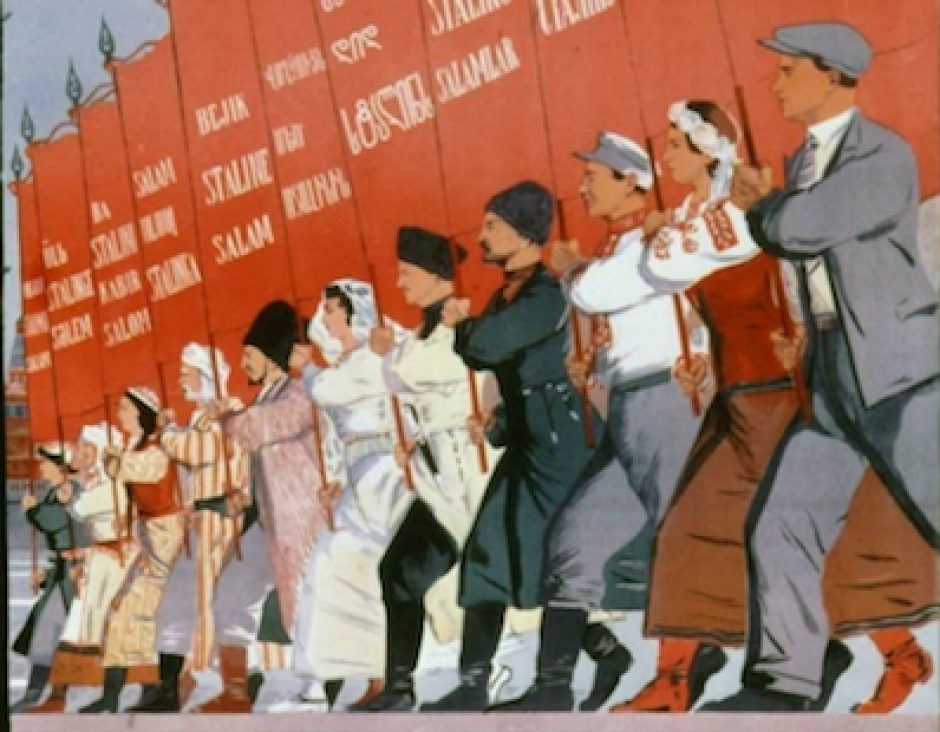In 1944, Stalin started initiatives to recognize mothers both financially and symbolically. Why 1944? In the midst of World War ll, the Soviet Union had a couple of problems they had to face. One: while men were away at war, women were the primary care givers and providers for the family. Two: the war was resulting in many casualties; many Soviet troops were dying. It was in in the interest of the Soviet Union to boost population growth. Three: the wartime efforts were hurting the economy and families needed financial assistance. (Mitsuyosh 20-36)
To respond to these worries, Stalin created the honorary title of Mother Heroine and the civilian award Order of Maternal Glory. With these awards, he also expanded state aid to mothers with large families, families in general, and unmarried mothers. These initiatives were started by Stalin personally and recognizing mothers was a cause he felt would strengthen the Union. It would be nationalist in form and socialist in content.
The Mother Heroine award and recognition was established in 1944 and existed until the fall of the Union. This award was designed to recognize mothers that raised large families and each award came with state pensions for mothers and families that were awarded the honor. The title “Mother Heroine” was given to mothers that bore and raised families of ten or more children. During the span of this award’s existence, about 430,000 women were recipients.


This poster is a Soviet wartime poster that depicts a Mother Heroine. It reads: “Glory to Mother Heroines!” This poster celebrates the mother, especially during the war when husbands were away and the task to raise largefamilies fell on mothers alone. This poster seeks to show that the effort that mother’s contributedto the war was an equally heroic effort.

The Order of Maternal Glory was established at the same time as the Mother Heroine award. It recognized mothers that bore and raised large families, but not as large as 10 or more children. The order was divided into three classes additionally: mothers raising 9 children (1st class), mothers raising 8 children (2nd class) and mothers raising 7 children (3rd class). Recipients were given medals (pictured below).

Connected to, and often included with these awards, the Soviet Union offered a great deal state aid to families, mothers, pregnant women, and unmarried women. The more children a mother raised, the more money this aidwould include. More aid was available for additional children, pregnant women, and women that were unmarried. (Heer and Bryden 153-163)This aid was in the form of grants, allowance, and tax deductions/exemptions. These lines are from the edict on increasing State aid to mothers and families. To establish that State allowances are to be granted to mothers of large families (whether the husband is living ornot) on the birth of the third child and of each subsequent child, instead of the existing procedure of granting State allowances to mothers of six children on the birth of the seventh and of each subsequent child. Monthly allowances to mothers of large families are to bepaid beginning with the second year of the child’s life and continuing until the child reaches the age of five. Citizens paying income tax will be taxed to the extent of six per cent of their income in the absence of children, one per cent if they have one child and one-half per cent if they have two children. Mothers with families of three, four, five or six children at the date of issue of the present Edict will receive allowances under the present Article for every child born after the publication of the present Edict.
This recognition and celebration of mothers was deeply socialist. First, it recognized reproductive labor, a labor that often goes unrecognized in Western bourgeoisie culture. To be a true society made up of proletariats, all forms of labor must be celebrated and encouraged — both productive labor and reproductive labor. A big part of building socialism was mobilizing women and separate them from the female bourgeoisie experience and the experience of a peasant woman. (Mitsuyosh 20-36) Women doing all sorts of labor were recognized and encouraged in this time, too.
“Pro-natalist” campaigns were connected with women’s liberation. This type of liberation appealed to many nations, especially nations that are non-Western and value reproductive labor. Post-war, this campaign was really pushed because of the many lives lost from the war. Women had this important responsibility: to provide the Soviet Union with its new generation of Socialists. Heroines of novels were often women that were proud to bring up children in the Soviet Union – “as a free citizen in the country of socialism.” (Mitsuyosh 20-36)
Not to forget, raising large families was very anti-bourgeoisie. In 1955, by Khrushchev said I955 that ‘bourgeois ideology invented many cannibalistic theories, among them the theory of over-population. Their concern is to cut down the birth rate, reduce the rate of population increase. It is quite different with us, comrades. If about 100 million people were added to our 200 million, even that would not be enough. (Heer and Bryden 153-163)
Stalin’s initiative recognized women — the people that raise the new generations of the socialist proletariat — and connected nations with honors and recognition of reproductive labor. The women’s movement in general is socialist in content and works to incorporate everyone into the working class. Recognizing the different ways in which Soviets contribute to their societies and the different work they contribute is so important for a society of equal, socialist, citizens.
Sources:
- Mitsuyoshi, Yoshie. Public Representations of Women in Western Ukraine under Late Stalinism: Magazines, Literature, and Memoirs. Jahrbücher für Geschichte Osteuropas, Neue Folge, Bd. 54, H. 1. page 20-36. 2006.
- Heer and Bryden, Judith and David. Family Allowances and Fertility in the Soviet Union. Soviet Studies, Vol. 18, No. 2, page 153-163. 1966
Pictures are from wikipedia and http://windowsonwar.nottingham.ac.uk/poster/Glory-to-Mother-Heroines.
